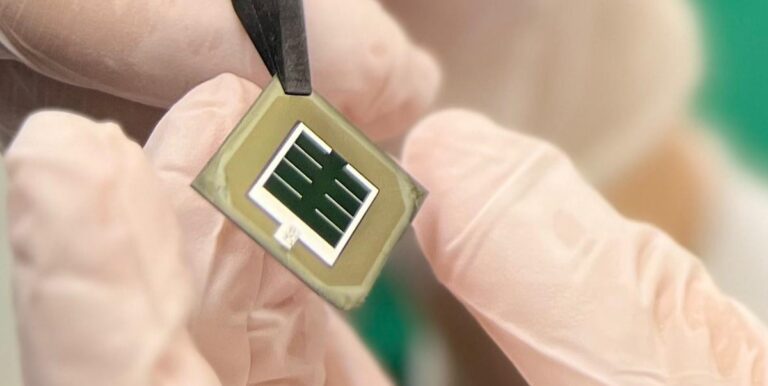The perovskite-silicon tandem device has a two-terminal configuration and a 2D perovskite layer on the bottom. It was able to maintain approximately 80% of its original efficiency for 1,700 hours.
A group of researchers from King Abdullah University of Science and Technology (KAUST) in Saudi Arabia and Helmholtz-Zentrum Berlin (HZB) in Germany have fabricated a perovskite-silicon tandem solar cell that reportedly achieves efficient charge extraction and interfacial passivation.
“Perovskite-silicon tandems have convincingly proven their high performance potential, with many groups now achieving efficiencies of more than 30%,” the study’s lead author Stefaan De Wolf told pv magazine. “However, translating these results from a laboratory environment into techniques relevant to industry requires attention, especially to solution processing techniques. Here we show certified efficiencies of over 31% using sheet-coated perovskites. The devices demonstrate improved performance due to contact passivation using 2D perovskites.”
In the study “Efficient perovskite/silicon tandems with sheet coating via interface engineering”, which was recently published in Joulethe academics explained that they used blade coating instead of spin coating as the latter currently suffers from scalability issues due to limited throughput. In particular, it was used to deposit the 3D perovskite on a 2D perovskite layer in the perovskite top device, which had a pin-inverted device configuration.
“By tuning the target dimensionality(s) of the 2D perovskite film, which is created prior to the 3D perovskite film, we minimize the bottom-end energy level mismatch, achieve efficient hole extraction, and reduce performance losses in our met knife coated pin devices,” the scientists said, noting that this configuration helped the best perovskite device achieve a power conversion efficiency of 22.6%, an open-circuit voltage of 1.23V, and a fill factor (FF) of 82%.
With this device, the research group built an encapsulated tandem device of 1 cm2 based on a substrate made of indium tin oxide (ITO), several layers of amorphous silicon (a-Si), a crystalline silicon absorber, a transparent back contact made of indium zinc oxide (IZO), the 2D perovskite layer, the knife-coated 3D perovskite layer, a p-phenylenediaminium iodide (PDAI) layer, an electron transport layer (ETL) made of thermally evaporated buckminsterfullerene (C60), a tin oxide (SnO2) layer, another IZO layer, an anti-reflective coating based on magnesium fluoride (MgF2) and a silver (Ag) metal contact.
Interested in more insights about Saudi Arabia?
This tandem cell has been tested under standard lighting conditions and has also shown that it can maintain approximately 80% of its initial efficiency for 1,700 hours under 1 sun. “Our overall strategy, with a robust perovskite composition and a 2D interface on the bottom, made it possible for the first time in the literature to certify sheet-coated tandems, with an efficiency of 31.2% measured at the Fraunhofer Institute for Solar Energy (ISE) Systems,” the scientists said. declared.
KAUST announced in August that it achieved 33.7% efficiency for a perovskite-silicon tandem device using a new perovskite additive known as tetrahydrotriazinium. In 2021, HZB announced that it was a perovskite-silicon tandem cell with an efficiency of 29.80%, which was a world record for this cell architecture at the time.
The most efficient tandem device to date is a 34.6% efficient cell presented in September by Chinese manufacturer Longi.
This content is copyrighted and may not be reused. If you would like to collaborate with us and reuse some of our content, please contact: editors@pv-magazine.com.


